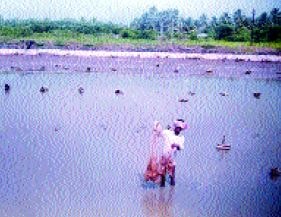DISCHARGING WATER FROM THE PONDS
It is preferable to be able to drain ponds by gravity than to have to pump the water out and, where this is possible, you should construct a ‘monk’ or sluice gate outlet structure. These structures (Figure 56) will allow you easily to control water depth and drainage speed and can be screened to prevent the loss of stock. In flowthrough water management, water is continually flowing through this structure. The monk allows you to totally drain your pond and, more importantly, enables you to control the water level during seine harvesting operations, flushing and water circulation.
Static (non-flow-through) ponds can have a simple screened and plugged outlet pipe or a turn-down drain, as previously shown in Figure 40. Outlet structures, whether they are pipes or monks, must be carefully sized so that the pond does not drain too slowly (to prevent poor water quality during harvesting operations), and they should be sited so that the pond can be totally drained (Figures 57 and 58). Table 13 gives the appropriate pipe sizes for ponds with monk outlets, for example, while Table 14 gives the time to drain a pond under various circumstances. Figure 59 is an illustration of a sluice gate structure.
The top of the sluice gate should also be constructed at least 50 cm above the highest pond water level as a safety measure. Detailed information on these topics can be found in other FAO manuals (FAO 1992b, 1995).
Where the pond outlet is a pipe below water level, there should also be an overflow pipe inserted about 20-30 cm below the top of the pond bank but above the normal water level in the pond. This overflow pipe should be screened in the same way as the normal pond outlet, to prevent loss of stock. If the water level in the area to which the pond drains also rises, however, the overflow pipe will be ineffective.
TABLE 13 Sizes of outlet pipes for ponds with monks
POND SIZE (m2) INSIDE DIAMETER OF PIPE (cm)
<200 not less than 10
200-400 10-15
400-1 000 15-20
1 000-2 000 20-25
2 000-5 000 25-30
>5 000 40 or more
TABLE 14 Time taken to drain ponds (in hours) with different drain pipe sizes

NOTE: THESE FIGURES ASSUME AN INITIAL WATER DEPTH OF 1 M, WITH PIPE VELOCITY LIMITED TO 1 M/SECOND; IF YOU HAVE TWO PIPES, THE TIME FOR DRAINING IN EACH CASE WOULD BE HALVED.
SOURCE: DERIVED FROM FAO (1995)
Where drainage by gravity is not feasible because of the limitations of the site, the only way to empty the pond or control its water level is by pumping. A screened ‘long-tail’ pump is one method of emptying ponds on flat sites (Figures 60 and 61). These pumps are readily available because they are used for paddy-field irrigation.
When water is discharged, enriched water and waste solids should be treated to prevent adverse effects on receiving waters, or to permit some or all of the pond water to be reused at various stages, pumped back for the same ponds, or drained into other systems downstream. Solids removal is the main form of treatment, usually based on sedimentation in settling ponds. Aeration may be used to increase oxygen levels, and algal growth in the settling ponds may help to remove nutrients. Every effort should be made to minimize water exchange, in order to reduce effluent loading and to conserve the water supplies themselves; water is essential to many forms of human activity and its use needs to be responsible.
The topics of harvesting and harvest structures are dealt with later in this manual.
More information on outlet structures can be found in Muir and Lombardi (2000) and details about their construction are contained in several other FAO manuals (e.g. FAO 1992b, 1994).
Figure 57
Most prawns will have been previously removed by seining; the rest are harvested not only at the drain but also by cast net (as shown in this photo from India) while draining proceeds.

NOTE: PIPES HAVE BEEN USED AS PRAWN SUBSTRATES (SHELTERS) IN THIS POND SOURCE: STEPHEN SAMPATH KUMAR